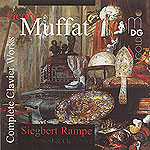Fans of the eccentric late-17th century composer Georg Muffat will delight in this premiere recording of his complete keyboard works, performed by Siegbert Rampe. One reason is their newfound importance. According to Rampe, recent scholarship has revealed these pieces to be the earliest examples of a composer substituting character-allusion titles for movements instead of using traditional dance markings–predating François Couperin by at least nine years. Rampe goes on to explain that Muffat also was the first to compose a keyboard work (the first Partita in F major) that completely eschews standard markings, instead combining character titles with “modish” French dances such as the Ballet, Gavotte, and Rigodon–predating Couperin again by at least 12 years. If this news isn’t thrilling enough, Rampe continues, declaring Muffat to be the first to combine French and Italian stylistic elements within the same suite (the Partita in C major), a feat previously attributed either to Couperin or Bach (who incidentally admired Muffat). Regardless of these revelations, the best reason to acquire Rampe’s new MDG offering is because it’s doubtful Muffat’s fascinating keyboard oeuvre could be better served than it is here.
The second-movement Allemande of the Partita in D minor is an early delight, with its numerous couplets of cascading figures illuminating the theme throughout. The witty Ballet movement of the aforementioned Prelude in F major equally fascinates with its silly mock-noble clusters of trills set against an inordinately rigid pulse. You also would be hard pressed to find a lovelier, more refined evocation of period intimacy and elegance than Muffat’s brief Sarabande, featured in a second Partita in F major.
Lest you mistakenly believe that your power amplifier suddenly went out of phase, Rampe’s performance of the final work (the aforementioned Partita in C major) on clavichord instead of the full-bodied harpsichord he has employed up until this point may come as a shock to those unfamiliar with this very quiet, most intimate-sounding of instruments. As a precursor to the harpsichord, this early keyboard instrument produces very soft sounds by means of metal blades attached to the inner ends of the keys gently striking the strings. However, given the instrument’s inherent dynamic limitations, Rampe does a formidable job drawing on its expressive possibilities, particularly in the first Gavotte and lovely seventh-movement Pastorella. Clavichord recordings are rare–and rarer still are those that are this true-to-life. MDG’s sound is audiophile quality with plenty of presence and detail. As suggested earlier, Rampe’s thorough notes are informative and feature many fascinating anecdotes. Highly recommended.
































